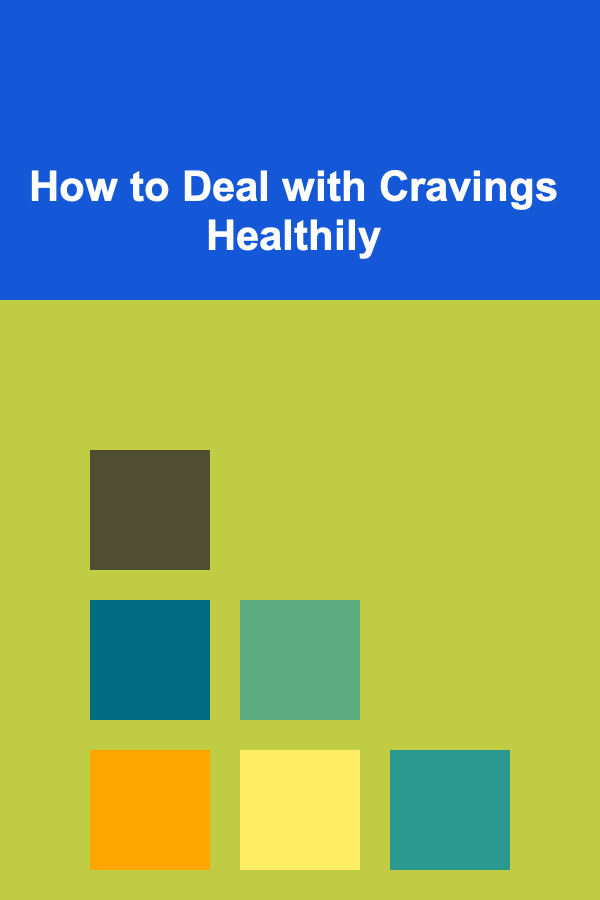
How to Deal with Cravings Healthily
ebook include PDF & Audio bundle (Micro Guide)
$12.99$6.99
Limited Time Offer! Order within the next:

Cravings are a common experience, something nearly everyone deals with at some point in their life. Whether it's for something sweet, salty, or fatty, cravings often feel overpowering and difficult to resist. However, not all cravings need to be viewed as something negative or detrimental to our health. In fact, cravings can be understood and managed in ways that support both mental and physical well-being.
This article will explore the science behind cravings, the different types of cravings we experience, and, most importantly, how to deal with cravings healthily. With the right tools and strategies, you can manage your cravings without feeling guilty, while still enjoying a balanced and nourishing diet.
Understanding Cravings
Cravings are intense, often sudden desires for specific foods, and they differ from hunger. While hunger is a general, physical need for food, cravings are more specific and can often be linked to emotional or psychological factors.
There are two primary reasons why we experience cravings:
1.1 Physiological Reasons
Physiological cravings are linked to biological needs, and they are often a response to nutritional deficiencies or imbalances in our body. For example, if you are lacking certain vitamins or minerals, your body might crave foods that contain those nutrients. This is a natural survival mechanism, designed to ensure that you maintain an adequate supply of nutrients for your body's functions.
1.2 Emotional and Psychological Reasons
Emotional and psychological cravings are often triggered by stress, boredom, anxiety, or even happiness. Many people turn to comfort foods---such as chocolate, chips, or ice cream---when they are feeling emotionally vulnerable or overwhelmed. These foods are typically high in sugar or fat, and they activate the brain's reward system, providing a temporary feeling of pleasure or relief.
For many, emotional cravings are not driven by a true need for food but by a desire for comfort or distraction.
Types of Cravings
There are several different types of cravings, each with its own underlying causes. Understanding the type of craving you're experiencing can help you deal with it in a healthier way.
2.1 Sweet Cravings
Sweet cravings are perhaps the most common type of craving. They often arise when blood sugar levels drop, or if you're feeling tired, stressed, or even bored. Sweet foods, especially those high in sugar, trigger the release of dopamine, the brain's "feel-good" neurotransmitter. This can lead to an emotional craving for something sweet to experience that brief pleasure.
2.2 Salty Cravings
Salty cravings are also frequent, and they can be triggered by dehydration or an electrolyte imbalance. The body needs sodium to maintain proper fluid balance and nerve function, so when these levels drop, the body may signal a craving for salty foods. Additionally, some people may crave salty snacks when stressed, as they may provide a comforting crunch and savory taste.
2.3 Fatty Cravings
Fatty cravings often arise when the body is seeking out a rich source of calories. The body needs fat for energy, and sometimes cravings for fatty foods, such as fried items, cheese, or meat, can be the body's way of seeking that nourishment. These cravings may also be triggered by emotional eating, as fatty foods can induce a soothing feeling.
2.4 Carbohydrate Cravings
Carbohydrate cravings are often linked to emotional states like stress, anxiety, or sadness. Carbs, especially refined carbs like bread, pasta, or pastries, can raise serotonin levels in the brain, leading to feelings of comfort and calm. When you're feeling down, your body may crave carbs as a way to self-soothe and improve your mood.
2.5 Alcohol and Caffeine Cravings
Both alcohol and caffeine cravings are often a result of habitual consumption. Alcohol is commonly used as a way to relax or unwind, and it can create a mental association with stress relief or socializing. Caffeine, on the other hand, is typically craved for its stimulating effects, helping people stay awake or alert. Both can become addictive over time, leading to frequent cravings.
Health Risks of Unchecked Cravings
While indulging in cravings from time to time isn't inherently bad, regularly giving in to unhealthy cravings can have negative effects on both your mental and physical health.
3.1 Weight Gain and Obesity
Cravings for sugary, salty, or fatty foods are often linked to overeating, which can lead to weight gain. Consuming too many high-calorie, low-nutrient foods can contribute to an excess intake of calories, which the body stores as fat. Over time, this can lead to obesity, a condition associated with a higher risk of heart disease, diabetes, and other health problems.
3.2 Blood Sugar Imbalances
Consuming foods high in refined sugar can lead to rapid spikes and drops in blood sugar levels. This can result in a range of symptoms, from irritability and fatigue to mood swings and hunger pangs. Over time, frequent consumption of sugary foods can lead to insulin resistance and an increased risk of type 2 diabetes.
3.3 Nutritional Deficiencies
When cravings lead to a regular pattern of eating processed, nutrient-poor foods, you may miss out on the essential vitamins, minerals, and nutrients your body needs for optimal health. This can lead to deficiencies and weaken your immune system, leaving you more susceptible to illness and other health issues.
3.4 Addictive Behaviors
Some cravings, especially for sugar or caffeine, can lead to addictive behaviors. These substances activate the reward centers in the brain, creating a cycle of dependency. Over time, you may find yourself craving these substances more often, leading to an unhealthy relationship with food or drink.
Healthy Strategies to Deal with Cravings
Now that we understand the causes and risks associated with cravings, let's explore healthy strategies for managing them.
4.1 Stay Hydrated
Dehydration is often mistaken for hunger or cravings, especially when the body is in need of water rather than food. When you feel a craving coming on, try drinking a glass of water. This may help to reduce the intensity of the craving and prevent you from reaching for unhealthy snacks.
In addition to water, herbal teas or infused waters (such as lemon or cucumber water) can also be a refreshing way to stay hydrated and curb cravings.
4.2 Eat Balanced Meals
One of the most effective ways to prevent cravings is by ensuring that you eat balanced, nutrient-dense meals throughout the day. When your body is well-nourished and energized, it's less likely to crave unhealthy foods. A balanced meal should include:
- Proteins (chicken, turkey, tofu, legumes)
- Healthy fats (avocados, olive oil, nuts, seeds)
- Complex carbohydrates (whole grains, vegetables, legumes)
- Fiber (fruits, vegetables, whole grains)
By eating regular, balanced meals, you can keep blood sugar levels stable and reduce the likelihood of intense cravings.
4.3 Practice Mindful Eating
Mindful eating involves paying full attention to the experience of eating, focusing on the taste, texture, and aroma of your food, as well as recognizing when you feel satisfied. This practice can help reduce emotional cravings by bringing awareness to why you're eating---whether it's because you're truly hungry or simply reacting to stress or emotions.
4.4 Find Healthy Alternatives
Instead of giving in to cravings for sugary, salty, or fatty foods, try healthier alternatives that can satisfy your hunger without compromising your health goals. For example:
- For sweet cravings: Try fruit, yogurt with honey, or dark chocolate.
- For salty cravings: Opt for air-popped popcorn, roasted nuts, or edamame.
- For fatty cravings: Try avocado on whole grain toast or hummus with vegetables.
- For carbohydrate cravings: Go for whole grain crackers, oats, or quinoa.
Choosing healthier alternatives can help satisfy your cravings while still providing your body with essential nutrients.
4.5 Get Enough Sleep
Lack of sleep can disrupt the balance of hunger-related hormones, making you more susceptible to cravings. When you're sleep-deprived, the body produces more ghrelin, a hormone that stimulates appetite, while reducing leptin, a hormone that signals fullness. As a result, you may experience stronger cravings, especially for high-calorie, comforting foods.
Aim for 7--9 hours of quality sleep each night to help regulate your appetite and minimize cravings.
4.6 Manage Stress
Stress is a major trigger for emotional eating and cravings. High levels of stress increase cortisol production, which can lead to cravings for sugary or fatty foods. Incorporating stress management techniques into your daily routine can help reduce cravings and improve your overall well-being. Consider practices such as:
- Meditation
- Yoga
- Deep breathing exercises
- Journaling
- Taking breaks throughout the day
By managing stress effectively, you can reduce the emotional triggers that lead to unhealthy cravings.
4.7 Practice Portion Control
Sometimes, cravings are more about the amount of food than the food itself. If you're craving a specific food, try having a small portion instead of indulging in a large amount. This can help you satisfy the craving without overdoing it. Using smaller plates or serving sizes can also help with portion control.
4.8 Distract Yourself
If a craving strikes, try distracting yourself with a different activity. Go for a walk, read a book, or call a friend. Oftentimes, cravings will pass if you allow your mind to shift focus. Engaging in a non-food-related activity can give your brain time to recalibrate and allow the craving to subside.
Conclusion
Cravings are a natural part of life, and they don't need to be viewed as obstacles to a healthy lifestyle. By understanding the root causes of cravings and adopting mindful strategies, you can deal with them healthily and without guilt. Whether it's staying hydrated, practicing mindful eating, finding healthier alternatives, or managing stress, there are many tools you can use to reduce the impact of cravings on your health.
Remember, balance is key. It's okay to indulge in cravings from time to time, but developing healthy habits to manage them will empower you to make better choices that support both your physical and emotional well-being. By addressing the underlying causes of cravings and developing healthy coping mechanisms, you can achieve a more balanced and fulfilling relationship with food.

How to Host a Successful Potluck Party with a Guest-Submitted Menu
Read More
How to Install Recessed Lighting in Your Home
Read More
How to Organize Your Personal Records for Easy Retrieval
Read More
How to Soundproof a Home Music Studio for Optimal Sound Quality
Read More
How to Use Lighting to Make Small Spaces Look Bigger
Read More
Choosing Sustainable Materials for Renewable Energy Installations: A Deep Dive
Read MoreOther Products

How to Host a Successful Potluck Party with a Guest-Submitted Menu
Read More
How to Install Recessed Lighting in Your Home
Read More
How to Organize Your Personal Records for Easy Retrieval
Read More
How to Soundproof a Home Music Studio for Optimal Sound Quality
Read More
How to Use Lighting to Make Small Spaces Look Bigger
Read More